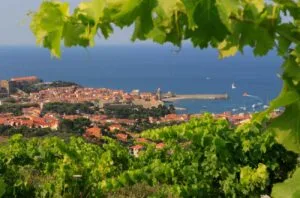You could almost hear the vineyards gurgling with pleasure: this April drench came after three years of drought. A pair of trail runners emerged from a path through the bushes just beneath us, their 400m climb over, sodden, panting, beaming. ‘All that effort for nothing,’ lamented one of the wine- growers, shaking his head in wry amusement. ‘And we can’t get people to work on the vines.’
This is Collioure, in all its astonishment and difficulty. It could be a little mountain Burgundy of the south – or perhaps France’s miniature Etna. Its main grape variety, Grenache, is the Pinot of hot places: pale, delicate, nuanced and subtle, capable of casting spells with its perfumed twill of dappled acidity and tender tannin. If you want ‘saline’, if you want ‘stone’, your tongue will find them in white Collioure; they rival the reds in force and beauty of expression. The hills are hammered and squeezed into a series of schist amphitheatres: beckoning nuance, intimating wealth of expression. And all… still hidden.
Hidden? ‘Banyuls kills terroir,’ said the appellation president Romuald Peronne of Clos Saint Sebastien. Remember that Banyuls and Collioure occupy the same territory – and he wasn’t criticising the region’s historical wine, either. He simply meant that the fortification, oxidation and extended ageing of Banyuls turns them from wines of place into wines of method, in large part: prized they may be, but you drink time, craftsmanship and regional expression rather than the uniqueness of a parcellaire (single-vineyard wine) in







